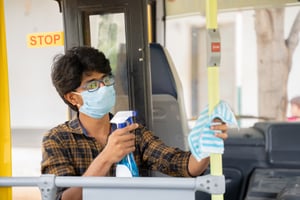Keeping Your School Buses Clean And Hygienic During The Coronavirus Outbreak
published on December 03, 2020 by Sonia Mastros
school bus management, school bus safety, school bus maintenance, covid-19, school bus cleaning
 How has your district updated school bus cleaning policies to adapt to the coronavirus outbreak?
How has your district updated school bus cleaning policies to adapt to the coronavirus outbreak?
Providing transportation to students is a must, even during a pandemic, but school buses create a significant new potential source of infection. Any student - or other riders - could theoretically be infected and contagious at any time, even if they do not yet show symptoms of COVID-19. If they are infectious, then their presence on the bus will leave plenty of contaminants behind - on the seats, the windows, the doors, the floors, even in the air within the bus.
Districts running school buses in 2020 must have updated cleaning procedures to deal with this. Sanitation and disinfection must be a regular part of the cleaning routine.
Six Tips for Cleaning and Sanitizing Buses During an Outbreak
1. Identify All "High Touch" Areas on Your School Buses
Anything a child might touch can potentially become a vector for disease spread, so it's important to focus on anything which will be touched frequently. If you have camera footage available, study the footage carefully to see where students are putting their hands. It might surprise you! Or at least sit in the bus personally, and look for anything that's within arm's reach of each student.
2. Start With the Floors
While cleaning typically goes top-down, starting at the floor is a good idea if there's a risk of infection. That way the cleaner won't kick up contaminated dirt and debris from the floor as they do the rest of the cleaning. If this requires an extra pass over the floor at the end of the cleaning, so be it.
3. Use Touchless Cleaning Processes When Possible
Machines such as "spray and vac" vacuums have very little direct contact with the floors and other surfaces, and that's a good thing. Any contact could potentially spread viral loads around.
4. Do Not Mop!
Mops are good for quick cleaning, but terrible for sanitation. They just smear potentially infected debris around, without doing anything to kill or remove any remaining viruses.
5. Use Microfiber Cloths
Microfiber cleaning cloths will be best for dealing with potentially contaminated areas because they grab more dirt while leaving fewer fibers behind. These should be your go-to for detail work.
6. Clean, Then Disinfect
Disinfectants will not work properly on dirty surfaces. This should always be a two-stage process. Do the surface level cleaning, then apply disinfectant to the cleaned surfaces. Otherwise, the sanitation will be far less effective.
How are you keeping your school buses clean and sanitary during the outbreak? Do you have any good tips to pass along? Let people know in the comments!



